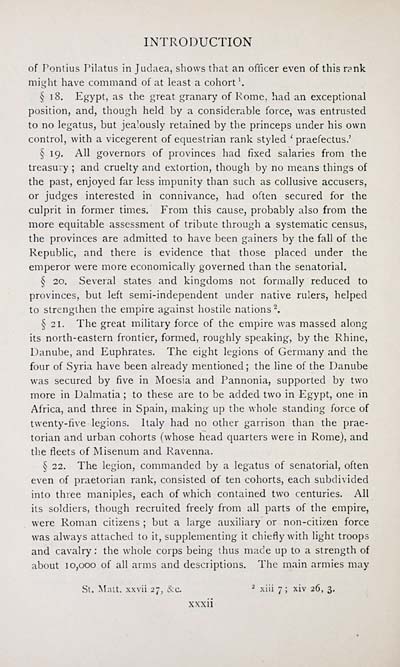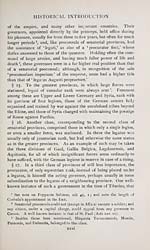Download files
Complete book:
Individual page:
Thumbnail gallery: Grid view | List view

INTRODUCTION
of Pontius Pilatus in Judaea, shows that an officer even of this r?nk
might have command of at least a cohort '.
§ 18. Egypt, as the great granary of Rome, had an exceptional
position, and, though held by a considerable force, was entrusted
to no legatus, but jealously retained by the princeps under his own
control, with a vicegerent of equestrian rank styled ' praefectus.'
§ 19. All governors of provinces had fixed salaries from the
treasury ; and cruelty and extortion, though by no means things of
the past, enjoyed far less impunity than such as collusive accusers,
or judges interested in connivance, had often secured for the
culprit in former times. From this cause, probably also from the
more equitable assessment of tribute through a systematic census,
the provinces are admitted to have been gainers by the fall of the
Republic, and there is evidence that those placed under the
emperor were more economically governed than the senatorial.
§ 20. Several states and kingdoms not formally reduced to
provinces, but left semi-independent under native rulers, helped
to strengthen the empire against hostile nations ^
§ 21. The great mihtary force of the empire was massed along
its north-eastern frontier, formed, roughly speaking, by the Rhine,
Danube, and Euphrates. The eight legions of Germany and the
four of Syria have been already mentioned ; the line of the Danube
was secured by five in Moesia and Pannonia, supported by two
more in Dalmatia ; to these are to be added two in Egypt, one in
Africa, and three in Spain, making- up the whole standing force of
twenty-five legions. Italy had no other garrison than the prae-
torian and urban cohorts (whose head quarters were in Rome), and
the fleets of Misenum and Ravenna.
§ 22. The legion, commanded by a legatus of senatorial, often
even of praetorian rank, consisted of ten cohorts, each subdivided
into three maniples, each of which contained two centuries. All
its soldiers, though recruited freely from all parts of the empire,
were Roman citizens ; but a large auxiliary or non-citizen force
was always attached to it, supplementing it chiefly with light troops
and cavalry : the whole corps being thus made up to a strength of
about 1 0,000 of all arms and descriptions. The main armies may
St. Malt, x.xvii 27, i<;c. ^ xiii 7 ; xiv 26, 3.
of Pontius Pilatus in Judaea, shows that an officer even of this r?nk
might have command of at least a cohort '.
§ 18. Egypt, as the great granary of Rome, had an exceptional
position, and, though held by a considerable force, was entrusted
to no legatus, but jealously retained by the princeps under his own
control, with a vicegerent of equestrian rank styled ' praefectus.'
§ 19. All governors of provinces had fixed salaries from the
treasury ; and cruelty and extortion, though by no means things of
the past, enjoyed far less impunity than such as collusive accusers,
or judges interested in connivance, had often secured for the
culprit in former times. From this cause, probably also from the
more equitable assessment of tribute through a systematic census,
the provinces are admitted to have been gainers by the fall of the
Republic, and there is evidence that those placed under the
emperor were more economically governed than the senatorial.
§ 20. Several states and kingdoms not formally reduced to
provinces, but left semi-independent under native rulers, helped
to strengthen the empire against hostile nations ^
§ 21. The great mihtary force of the empire was massed along
its north-eastern frontier, formed, roughly speaking, by the Rhine,
Danube, and Euphrates. The eight legions of Germany and the
four of Syria have been already mentioned ; the line of the Danube
was secured by five in Moesia and Pannonia, supported by two
more in Dalmatia ; to these are to be added two in Egypt, one in
Africa, and three in Spain, making- up the whole standing force of
twenty-five legions. Italy had no other garrison than the prae-
torian and urban cohorts (whose head quarters were in Rome), and
the fleets of Misenum and Ravenna.
§ 22. The legion, commanded by a legatus of senatorial, often
even of praetorian rank, consisted of ten cohorts, each subdivided
into three maniples, each of which contained two centuries. All
its soldiers, though recruited freely from all parts of the empire,
were Roman citizens ; but a large auxiliary or non-citizen force
was always attached to it, supplementing it chiefly with light troops
and cavalry : the whole corps being thus made up to a strength of
about 1 0,000 of all arms and descriptions. The main armies may
St. Malt, x.xvii 27, i<;c. ^ xiii 7 ; xiv 26, 3.
Set display mode to: Large image | Transcription
Images and transcriptions on this page, including medium image downloads, may be used under the Creative Commons Attribution 4.0 International Licence unless otherwise stated. ![]()
| Early Gaelic Book Collections > Matheson Collection > Cornelli Taciti annalium > (36) |
|---|
| Permanent URL | https://digital.nls.uk/76567351 |
|---|
| Description | Items from a collection of 170 volumes relating to Gaelic matters. Mainly philological works in the Celtic and some non-Celtic languages. Some books extensively annotated by Angus Matheson, the first Professor of Celtic at Glasgow University. |
|---|
| Description | Selected items from five 'Special and Named Printed Collections'. Includes books in Gaelic and other Celtic languages, works about the Gaels, their languages, literature, culture and history. |
|---|

